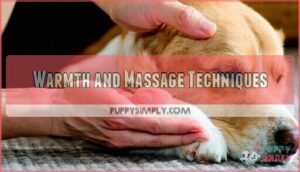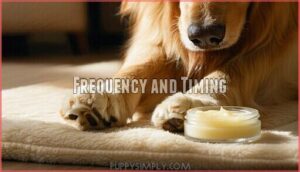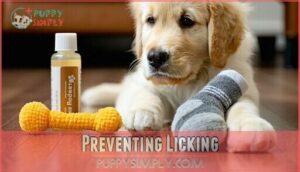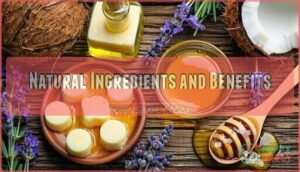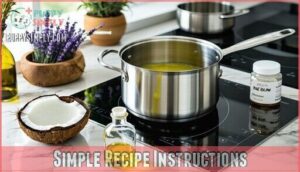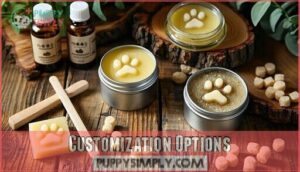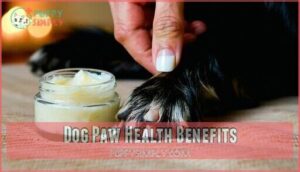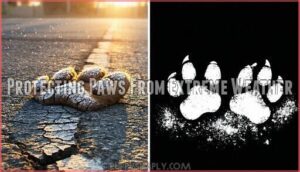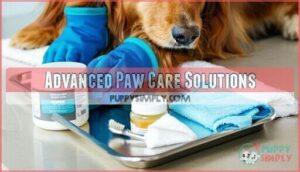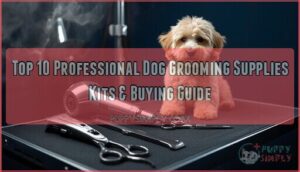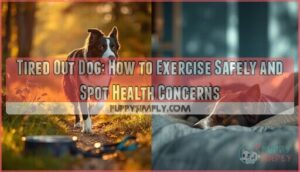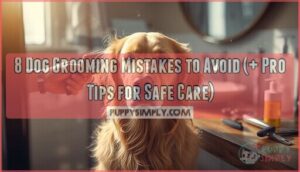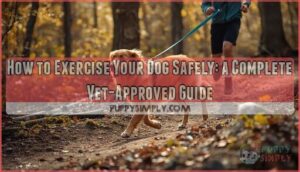This site is supported by our readers. We may earn a commission, at no cost to you, if you purchase through links.

A quality dog paw moisturizer protects against harsh surfaces, weather extremes, and everyday wear that can leave pads rough or split.
Look for balms with natural ingredients like shea butter, coconut oil, or beeswax that won’t harm your pup if they decide to taste-test their pedicure.
The best products create a protective barrier while deeply moisturizing damaged skin, and whether you choose a commercial balm or whip up your own kitchen creation, the right ingredients make all the difference, using elements like shea butter and coconut oil.
Table Of Contents
- Key Takeaways
- Dog Paw Care Basics
- Choosing Safe Ingredients
- Top 3 Dog Paw Moisturizers
- Applying Dog Paw Balms
- DIY Dog Paw Balm Recipes
- Dog Paw Health Benefits
- Protecting Paws From Extreme Weather
- Advanced Paw Care Solutions
- Frequently Asked Questions (FAQs)
- What is the best paw moisturizer for dogs?
- Is Paw balm good for dogs?
- How do I moisturize my dog’s paws?
- What is a dog paw lotion & Paw cream?
- Is Paw lotion safe for dogs?
- Is vetpro Paw balm good for dry paws?
- What to use to moisturize my dog’s paws?
- What moisturiser is good for dogs’ paws?
- Should you put vaseline on dog paw pads?
- How often should I apply paw moisturizer to my dog’s paws?
- Conclusion
Key Takeaways
- Choose natural, dog-safe ingredients – Look for balms with shea butter, coconut oil, or beeswax that won’t harm your pup if they lick their paws, and avoid products with harsh chemicals or essential oils that can cause toxicity.
- Apply balm consistently for best results – Use paw moisturizer 1-2 times daily, warming it in your hands first and massaging thoroughly into clean paw pads, with increased frequency during harsh weather conditions.
- Inspect paws weekly to catch problems early – Regular checks help you identify cuts, swelling, or dryness before they become serious infections, preventing minor issues from affecting your dog’s mobility and comfort.
- Protect paws from environmental hazards year-round – Apply balm before walks to create barriers against hot pavement, salt, ice, and rough surfaces, adjusting your protection strategy based on seasonal challenges your dog faces.
Dog Paw Care Basics
Your dog’s paws endure constant contact with rough surfaces, hot pavement, ice, and harsh chemicals that can cause cracking, blistering, and painful injuries.
Your pup’s paws face daily battles against harsh surfaces, chemicals, and extreme temperatures that demand your protective care.
Regular paw inspections help you identify early signs of damage like swelling, cuts, or dryness before they become serious health problems, which is crucial for preventing painful injuries.
Importance of Regular Inspections
Every week, check your dog’s paws like you’re reading a roadmap to their comfort.
Early detection of cuts, swelling, or discoloration prevents minor issues from becoming major paw injuries.
Regular paw care inspections reduce infection risk and maintain your dog’s mobility impact.
Think of it as preventive maintenance – catching problems before they affect your pup’s comfort levels and overall paw health.
Common Issues and Injuries
When inspecting your dog’s paws, watch for telltale signs of paw injuries like limping, bleeding, or whimpering.
Cracked paws often develop from paw pad trauma, while chemical burns from de-icing salt cause winter irritation.
Dog paw pad injuries include blistering, swelling, and torn nails. Pododermatitis causes inflammation when broken skin becomes infected, making injury prevention essential.
Environmental Hazards
Urban surfaces like hot pavement can burn your dog’s paws within seconds, while rural dangers include sharp rocks and thorns.
Chemical exposure from road salt, fertilizers, and cleaning products creates serious seasonal risks.
Winter paw protection becomes essential when ice-melting chemicals cause burns.
Terrain challenges from hiking trails to city sidewalks demand reliable paw balm and proper pet safety measures for effective paw protection.
Choosing Safe Ingredients
You’ll want to select dog paw balms with natural ingredients like coconut oil, shea butter, and beeswax that won’t harm your pet if they lick their paws.
Avoid products containing essential oils or harsh chemicals, and always choose balms specifically formulated for dogs to guarantee safety and effectiveness.
Natural Moisturizers
Natural ingredients work best for your dog’s sensitive paw pads.
These gentle components provide deep moisturization without harmful side effects that synthetic chemicals might cause.
- Coconut oil and shea butter – Essential DIY Ingredients that deeply hydrate while creating protective barriers
- Medical-grade honey – Honey Benefits include natural antibacterial properties and accelerated healing for minor cuts
- Plant-based waxes – Oil Properties from carnauba and candelilla offer long-lasting protection against environmental damage
- Rosemary and lavender – Herbal Infusions provide soothing aromatherapy while supporting skin health naturally
For a specialized solution, consider a natural paw soother.
Avoiding Harsh Chemicals
Just like reading food labels for yourself, scrutinizing paw balm ingredients protects your dog from harmful chemicals.
Skip products containing alcohol, artificial fragrances, or petroleum-based ingredients that cause chemical sensitivities.
Safe alternatives include coconut oil, shea butter, and beeswax.
Label reading helps identify petfriendly formulas.
Research ingredients beforehand—your paw product safety depends on avoiding harsh chemicals completely.
Consider using a petroleum free alternative for your dog.
Essential Oil Safety
Many pet owners don’t realize that certain essential oils in paw balm ingredients can trigger severe allergic reactions or reach dangerous toxicity levels in dogs.
Breed sensitivity varies substantially, making safe dilution practices absolutely critical when selecting products. It’s important to understand the essential oils toxicity risks to avoid harm.
Here’s what to watch for when choosing pet-friendly formulas:
- Avoid tea tree, citrus, and eucalyptus oils – these cause neurological symptoms
- Choose reputable brands that test for toxicity levels before release
- Look for natural ingredients like beeswax and vitamin E instead
- Test small amounts first to check for breed sensitivity issues
Top 3 Dog Paw Moisturizers
Choosing the right paw moisturizer protects your dog’s pads from cracking, dryness, and environmental damage. These three top-rated balms offer proven ingredients and effective protection for your pet’s paws.
1. Dog Paw Soother Balm Stick

Your dog’s paws deserve the same gentle care you’d give a baby’s delicate skin.
The Natural Dog Company Paw Soother Balm Stick delivers exactly that with its 100% organic, vegan formula. This convenient stick glides on easily, combining coconut oil, calendula, and jojoba oil to heal cracked pads naturally.
You’ll love how quickly it absorbs without leaving greasy residue. Apply it 2-3 times daily, especially before bedtime.
It’s completely safe if your pup licks their paws, making healing stress-free for both of you with the Natural Dog Company and its Paw Soother Balm Stick.
Best For: Dogs with dry, cracked, or irritated paws needing natural and safe daily moisturizing and protection.
- Made from 100% organic, vegan, and safe-to-lick ingredients.
- Convenient stick design for easy, mess-free application.
- Quick absorption without leaving a greasy residue.
- Some users report packaging issues with the stick sliding during use.
- Price may be a concern for budget-conscious buyers.
- Requires clean paws before application to avoid dirt sticking.
2. Pet Head Oatmeal Paw Butter Balm
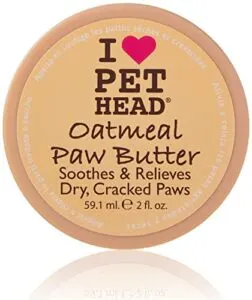
Pet Head’s Oatmeal Paw Butter delivers gentle relief for your dog’s rough, cracked paws.
This 2-ounce balm combines shea butter, coconut oil, and healing oatmeal extract to create a protective barrier against harsh surfaces.
You’ll appreciate its pH-balanced formula that’s safe if your pup decides to lick their paws clean.
Regular use can also prevent plaque and gum disease.
The pleasant oatmeal scent won’t overwhelm sensitive noses, and the vegan ingredients provide deep moisturization without parabens or artificial dyes.
Simply massage into clean paw pads for long-lasting comfort and protection.
Best For: Pet owners looking to soothe and moisturize their dog or cat’s dry, cracked paws with a vegan, pet-safe balm.
- Made with natural ingredients like shea butter and coconut oil.
- Safe for pets to lick with a pH-balanced formula.
- Protects and heals paws with a pleasant oatmeal scent.
- Scent intensity may not suit all pets.
- Some users find the balm’s texture oily or thin.
- Packaging size may feel smaller than expected.
3. Musher’s Secret Dog Paw Balm
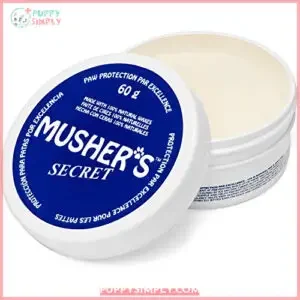
Originally formulated for sled dogs tackling Alaska’s brutal Iditarod race, Musher’s Secret creates an invisible shield that’ll make your pup’s paws winter-ready.
This Canadian-made balm contains food-grade waxes and vitamin E, offering year-round protection against salt, hot pavement, and rough terrain.
You’ll love how it absorbs quickly without leaving greasy residue on your floors. At 60 grams, this little jar goes the distance—perfect for active dogs who need reliable paw protection that won’t break the bank.
Best For: Active dogs of all sizes who need year-round protection for their paws in extreme weather or challenging terrains.
- Made from food-safe ingredients, ensuring safety even if licked.
- Provides year-round protection against snow, salt, hot pavement, and rough surfaces.
- Absorbs quickly and doesn’t leave a greasy residue on floors.
- Excessive licking may cause digestive issues in small dogs with sensitive stomachs.
- High fat content could trigger pancreatitis in some dogs.
- Container may arrive damaged in warm climates, potentially leaking product.
Applying Dog Paw Balms
You’ll get the best results from paw balms when you warm them in your hands first and massage them thoroughly into your dog’s paw pads.
Apply balms once or twice daily in thin layers, and distract your dog with treats to prevent immediate licking for better absorption.
Warmth and Massage Techniques
Warm your dog paw balm between your palms before application – this simple step transforms the experience.
The gentle heat softens the product for enhanced absorption while creating a bonding experience with your pup.
Many owners find products for paw care are helpful.
Use circular motions during paw massage to promote improved circulation and muscle relaxation. This technique provides pain relief for tired paw pads.
Frequency and Timing
Most dogs need paw balm application twice daily for best results.
Apply your dog paw moisturizer once in the morning before outdoor activities and again at bedtime for deeper absorption.
During winter months, increase application frequency to three times daily due to harsh conditions.
Active dogs require more frequent paw care routine adjustments, while puppies need gentler, less frequent applications.
Preventing Licking
After applying your dog paw balm, you’ll need to prevent licking to guarantee proper absorption.
Your pup’s natural instinct is to clean their paws, but this defeats the purpose of treatment.
Here are effective methods to stop paw licking:
- Distraction Techniques – Offer treats, toys, or engage in play immediately after paw balm application
- Bitter Sprays – Apply taste aversion products around treated areas to discourage licking
- Sock Use – Cover paws with clean socks for 10-15 minutes after application
- Elizabethan Collars – Use cone collars for persistent lickers who won’t respond to other methods
DIY Dog Paw Balm Recipes
You can create effective paw balm at home using simple ingredients like coconut oil, shea butter, and beeswax.
Making your own balm lets you control what goes on your dog’s paws while saving money compared to store-bought products.
Natural Ingredients and Benefits
Creating your own dog paw balm lets you harness nature’s healing power. Coconut Benefits include deep moisturizing and antibacterial protection, while Shea Butter forms a protective barrier against harsh elements.
Beeswax Protection seals in moisture, and Natural Oils like jojoba reduce inflammation. Adding Honey Healing properties and Vitamin E creates a veterinarian-approved formula that’s both safe and effective for your pup’s paws.
For year-round paw protection, consider a balm that offers all-in-one support with all-in-one support being crucial for your dog’s well-being.
Simple Recipe Instructions
Making homemade paw balm requires just five simple ingredients and basic kitchen tools.
This DIY remedy combines coconut oil, shea butter, and beeswax for superior paw protection.
- Melt 2 tablespoons each of coconut oil, shea butter, and beeswax in a double boiler
- Add 2 tablespoons olive oil and stir until completely combined
- Remove from heat and add 20 drops lavender essential oil
- Pour mixture into wide-mouth containers while still warm
- Allow to cool completely before first application
Customization Options
Once you’ve mastered the basic homemade paw balm recipe, you can tailor it to your dog’s specific needs.
Adjust balm consistency by adding more beeswax for firmer protection or extra oils for softer application.
Consider ingredient allergies when selecting oils, avoiding coconut if your pup’s sensitive.
For scent preferences, skip essential oils entirely or use dog-safe alternatives.
Choose packaging choices like small tins for portability.
Dog Paw Health Benefits
You’ll protect your dog’s paw pads from painful cracking and potential infections when you use moisturizing balms regularly.
These products support your pet’s natural healing process while maintaining the flexibility that keeps their paws comfortable during daily activities, which is crucial for their overall well-being and comfort.
Preventing Cracks and Infections
With proper dog paw pad health practices, you’ll prevent painful cracks that invite harmful bacteria.
Moisturizing frequency directly impacts your dog’s comfort and mobility, while early detection stops minor issues from becoming serious paw infections.
Here’s your prevention strategy:
- Apply paw pad moisturizer twice daily – morning and evening applications create consistent barrier protection
- Inspect paws weekly – check for early signs of paw cracks or swelling between toes
- Use barrier creams before walks – protective layers shield against rough surfaces and chemicals
- Maintain proper hygiene practices – clean paws after outdoor activities to prevent bacterial buildup
Supporting Natural Healing
Quality paw healing balm accelerates your dog’s recovery from minor cuts and abrasions.
Natural ingredients like honey healing properties and herbal remedies promote tissue repair at the cellular level.
These paw repair creams create protective oil barriers while delivering hydration support to damaged skin.
Your paw pad moisturizer basically jumpstarts the body’s natural healing mechanisms.
Excessive licking can be a sign of underlying paw issues.
Maintaining Paw Pad Flexibility
Flexible paw pads act like natural shock absorbers, cushioning your dog’s joints with every step.
Regular paw hydration prevents stiffness that can limit mobility and cause discomfort during walks.
Daily moisturizing keeps paw pads supple through:
- Collagen support from quality balm ingredients
- Paw softening that maintains elasticity
- Daily massages that improve circulation
- Breed differences requiring customized paw pad care
- Consistent hydration preventing painful cracks
Protecting Paws From Extreme Weather
Your dog’s paws face serious challenges from winter salt, hot pavement, and harsh weather conditions that can cause burns, cracks, and chemical irritation.
You’ll need targeted protection strategies that change with the seasons to keep your pet’s paw pads healthy and comfortable year-round.
Winter Care and Precautions
When winter’s harsh grip threatens your dog’s paws, proactive protection becomes essential.
Salt damage and ice burns can crack delicate paw pads within minutes of exposure. Apply dog paw balm before walks to create a protective barrier against winter dryness.
Indoor heating also strips moisture, requiring daily paw hydration. Consider boot alternatives when temperatures drop below freezing for thorough winter paw protection.
Summer Hazards and Prevention
Summer brings different challenges that can seriously damage your dog’s paws. Hot pavement becomes a burning hazard, while sand irritation and bug bites create additional risks.
Here are four critical summer paw protection strategies:
- Test pavement temperature – Hold your hand down for seven seconds
- Maintain proper hydration – Carry water for cooling and drinking
- Apply sunburn protection – Use balms before outdoor activities
- Schedule cooler walks – Early morning or evening outings only
During hotter months, be aware of potential heatstroke symptoms.
Year-Round Protection Tips
Beyond seasonal challenges, effective paw protection requires year-round vigilance.
Your dog’s breed differences influence their sensitivity to surfaces, while seasonal adjustments in your routine facilitate consistent hydration and protection.
Active lifestyle dogs need daily balm applications, especially before walks.
| Season | Surface Awareness | Protection Focus |
|---|---|---|
| Spring | Wet surfaces, mud | Moisture barrier, cleaning |
| Summer | Hot pavement protection | Cooling balms, timing walks |
| Fall | Rough terrain, debris | Healing ingredients, inspection |
| Winter | Winter paw care, salt | Thick wax protection, washing |
Effective protection also involves being mindful of the seasonal adjustments and how they impact your dog’s needs, ensuring that you provide the right care at the right time.
Advanced Paw Care Solutions
When regular paw balms aren’t enough to address severe dryness, infections, or persistent paw problems, you’ll need specialized solutions that go beyond basic moisturizing.
These advanced treatments include protective boots, medicated balms for pododermatitis, and professional veterinary interventions that target specific paw health issues.
Dog Boots and Alternative Protection
When paw balms aren’t enough for extreme conditions, dog boots offer maximum protection.
These protective booties shield paws from hot pavement, sharp terrain, and harsh chemicals. Boot materials like neoprene and rubber provide durability, while proper sizing prevents slipping.
Training acceptance takes patience—start with short sessions. Some dogs require boots that address dragging feet concerns for ideal paw protection.
Consider alternative footwear options like disposable booties for occasional use when traditional paw protection methods fall short.
Addressing Pododermatitis and Infections
Identifying pododermatitis requires recognizing red, swollen paws and excessive licking behavior.
This paw inflammation often signals bacterial or fungal paw infection requiring immediate veterinary intervention.
Your veterinarian will diagnose underlying causes and prescribe targeted treatments to prevent secondary complications.
Treating infections early maintains ideal dog paw health and prevents chronic issues that compromise your pet’s mobility and comfort, which is crucial for their overall well-being and requires immediate veterinary intervention.
Consultation and Veterinary Guidance
Sometimes your dog’s paw troubles need more than a simple balm fix.
When symptoms persist despite consistent care, it’s time to seek professional guidance from your veterinarian for proper diagnosis and treatment.
Here’s when to schedule that vet appointment:
- Symptom Persistence – Cracking, swelling, or limping continues after two weeks of regular dog paw balm application
- Underlying Conditions – Signs of infection, unusual discharge, or severe inflammation requiring prescription medication
- Medication Interactions – Your dog takes other medications that might conflict with topical treatments
- Professional Application – Complex cases needing specialized vet recommendations for advanced paw pad care protocols
Frequently Asked Questions (FAQs)
What is the best paw moisturizer for dogs?
Though you might think any lotion works, dogs need specialized balms.
Musher’s Secret and Natural Dog Company Paw Soother lead the pack, offering deep moisturization with natural ingredients that won’t harm if licked.
Is Paw balm good for dogs?
Yes, paw balm is excellent for dogs.
It moisturizes dry, cracked pads, creates protective barriers against harsh surfaces, and prevents infections.
You’ll find it especially helpful during winter months when salt and ice damage paws.
How do I moisturize my dog’s paws?
Dry paws can feel like sandpaper to your furry friend.
Apply dog-specific paw balm or moisturizer twice daily, massaging gently into clean paw pads.
Use products with natural ingredients like shea butter, coconut oil, or beeswax for best results.
What is a dog paw lotion & Paw cream?
Dog paw lotion and cream are lightweight, preventative moisturizers that keep your dog’s paw pads supple and hydrated.
They’re thin formulations that absorb quickly but may be easily licked off by curious pups.
Is Paw lotion safe for dogs?
Pet owners spend over $9 billion annually on specialized care products, yet many worry about paw lotion safety.
Quality dog paw lotions are absolutely safe when you choose products specifically formulated for canines, avoiding human lotions entirely, to ensure safe use.
Is vetpro Paw balm good for dry paws?
VetPro Paw Balm effectively treats dry, cracked paw pads with moisturizing ingredients like shea butter and natural oils.
You’ll see improvement with regular application, though it’s best to consult your vet for persistent issues, ensuring the best care for your pet.
What to use to moisturize my dog’s paws?
Cracked paws can cause serious discomfort.
You’ll want specialized dog paw balms containing coconut oil, shea butter, or beeswax.
Apply twice daily, massaging gently into clean pads for maximum absorption and protection.
What moisturiser is good for dogs’ paws?
Quality balms containing coconut oil, shea butter, and beeswax work best for your pup’s pads.
Musher’s Secret, Natural Dog Company Paw Soother, and Pet Head Oatmeal Butter offer excellent protection against cracking and environmental damage.
Should you put vaseline on dog paw pads?
Coincidentally, many dog owners reach for Vaseline when paw pads crack.
However, you shouldn’t use petroleum jelly on your dog’s paws—it’s not easily absorbed and creates slip hazards.
Choose dog-specific balms instead.
How often should I apply paw moisturizer to my dog’s paws?
Apply paw moisturizer once or twice daily, especially before bedtime.
Increase frequency during harsh weather conditions like winter salt exposure or summer heat.
Massage thin layers into clean, dry paw pads for maximum absorption.
Conclusion
Dogs walk an average of 7,000 steps daily, putting constant pressure on their paw pads.
Whether you choose a commercial dog paw moisturizer or create your own DIY balm, consistent care prevents painful cracks and injuries.
Regular application of quality balms with natural ingredients like shea butter protects against harsh surfaces and weather extremes.
Your dog’s paws deserve the same attention you give their coat and nails, and starting a routine today means happier walks tomorrow with healthy paws.


